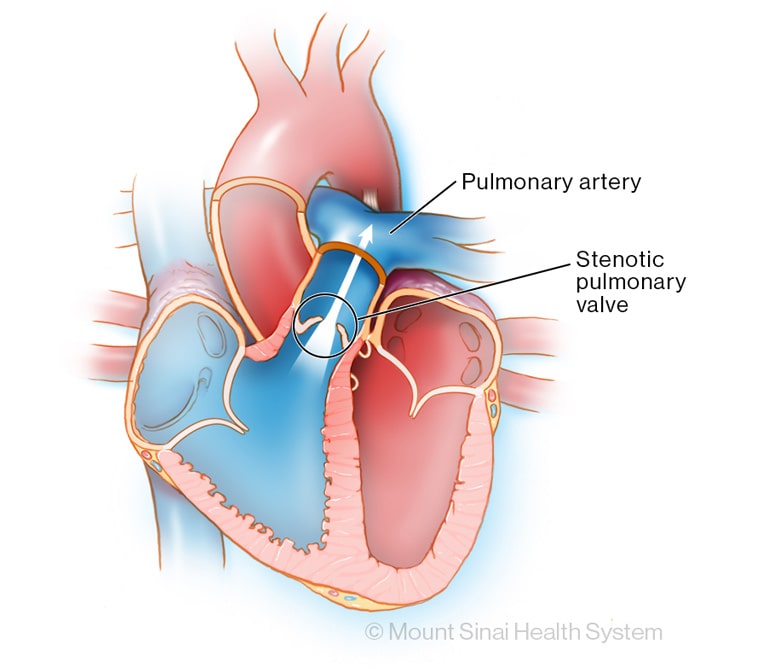Pulmonary Valve Stenosis
Our Mount Sinai Kravis Children’s Heart Center pediatric cardiologists have the experience to treat your child with mild, moderate, or severe pulmonary stenosis at any age. We are highly qualified in making an accurate diagnosis, explaining to you what is going on with your child, and advising you about the best possible treatment for your child.
About Pulmonary Stenosis
Pulmonary stenosis is narrowing of the pulmonary valve. Its job is to control blood flow from the right lower chamber (ventricle) of the heart to the lungs and prevent blood from leaking backwards. When the pulmonary valve is narrow (stenotic pulmonary valve), it causes the right ventricle to work too hard.

Symptoms
We may diagnose your child’s pulmonary stenosis as mild, moderate, or severe, which will direct us to design the appropriate type of treatment for your child.
- Mild-moderate: If your child has mild or even moderate pulmonary stenosis, you may not observe any symptoms, but a doctor may detect a heart murmur.
- Severe: With severe pulmonary stenosis, your child may experience limitations with activity (tiredness, shortness of breath). If there is also a hole between the top chambers of the heart, as in an atrial septal defect (ASD), oxygen levels may be low. Rarely, fainting can occur. In babies, there may be poor feeding or growth.
- Critical: In the most severe form of pulmonary stenosis, the valve is so narrow than not enough blood can get across to the lungs. Babies born with this form of pulmonary stenosis need immediate treatment.
Diagnosing your young child
Our pediatric cardiologist will diagnose your child’s condition usually after your primary care doctor detects a heart murmur and refers you to us.
To determine the best possible treatment, we may use some of the following diagnostic tests, including:
- Pulse oximetry—a painless way to monitor the amount of oxygen in your child’s blood
- Echocardiogram—a safe, noninvasive procedure that uses high frequency ultrasound to show the structure of your child’s heart, how blood flows through the heart, and overall how your child’s heart and circulatory system are working
- Electrocardiogram (ECG)—to measure electrical activity, which shows the heart’s chambers and how your child’s heart is beating
- Cardiac catheterization—minimally invasive procedure for diagnosis and sometimes treatment. Involves inserting a thin tube into the affected area to measure blood flow and pressure in the heart to determines severity of condition and if treatment is needed
- Chest X-ray—an image that can show the position and size of your child’s heart
Diagnosis before your baby is born
When your doctor notices signs of pulmonary stenosis in your unborn baby, you will get a referral to a doctor who specializes in pediatric cardiology. At Children’s Heart Center, we will monitor you and your baby during pregnancy and ensure a smooth transition of care for your baby to our neonatal service in collaboration with our pediatric cardiologist. We offer this care through our outstanding Fetal Heart Program.
Some forms of pulmonary stenosis can be genetic. If we suspect a condition such as Noonan syndrome, we can make a referral to our cardiovascular genetic program.
Treatments We Offer
Often, pulmonary valve stenosis can be treated with minimally invasive cardiac catheterization, though surgery is required for more significant or more extensive narrowing.
- Balloon valvuloplasty—this procedure is performed during a cardiac catheterization, where a thin, flexible tube with a small collapsed balloon at the tip is inserted into one of your child’s veins. The doctor guides it into the right side of the heart and across the narrowed valve. Using an X-ray, the interventional cardiologist positions the balloon in the narrow valve and inflates it to stretch the valve open.
- Surgery—if the pulmonary valve cannot be stretched using the balloon during the valvuloplasty procedure, our surgeon will perform open heart surgery to make a small cut in the narrowed valve to allow blood to flow. Sometimes, the valve will need to be patched to make it larger.
Following treatment, our pediatric cardiologists will continue to check your child into adulthood.
Why Choose Children’s Heart Center?
Our doctors and nurses at Children’s Heart Center provide the most personalized and expert care for your child with congenital heart disease, including pulmonary stenosis, from before birth through childhood. Our specialists use their expertise to diagnose and treat your child, using the latest and most effective minimally invasive techniques.
We are here for you, your child, and your family for life.